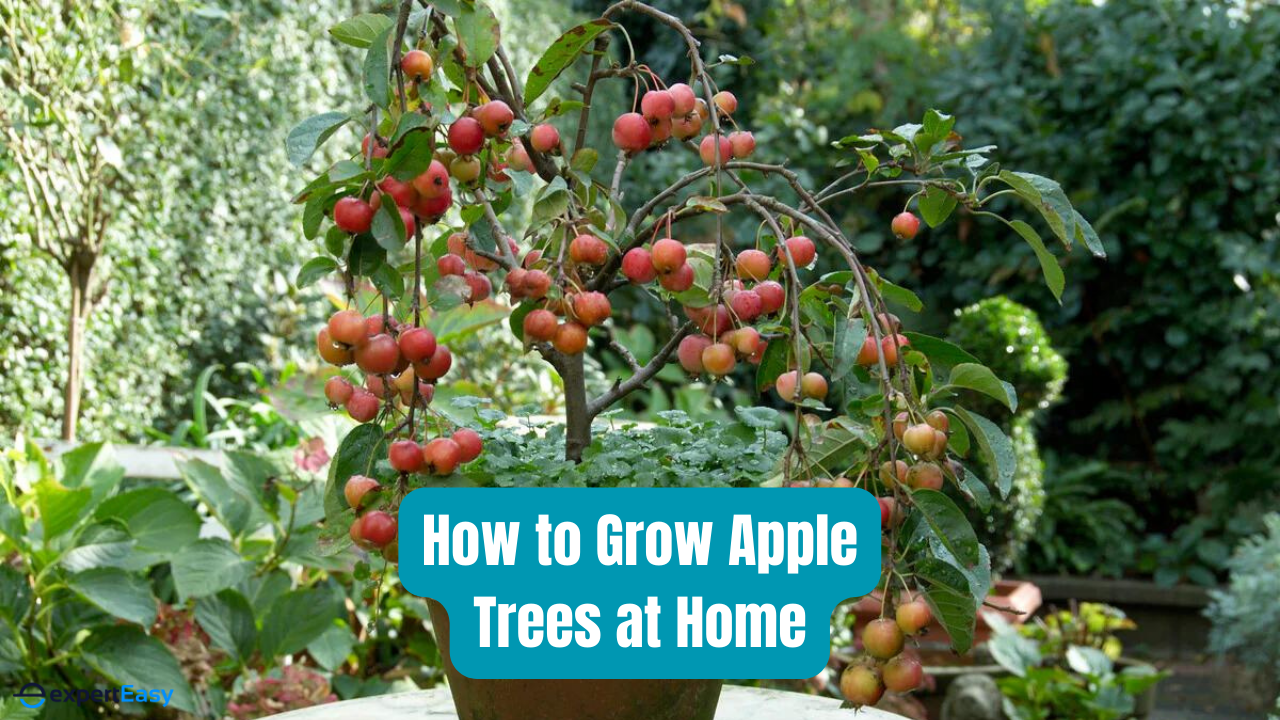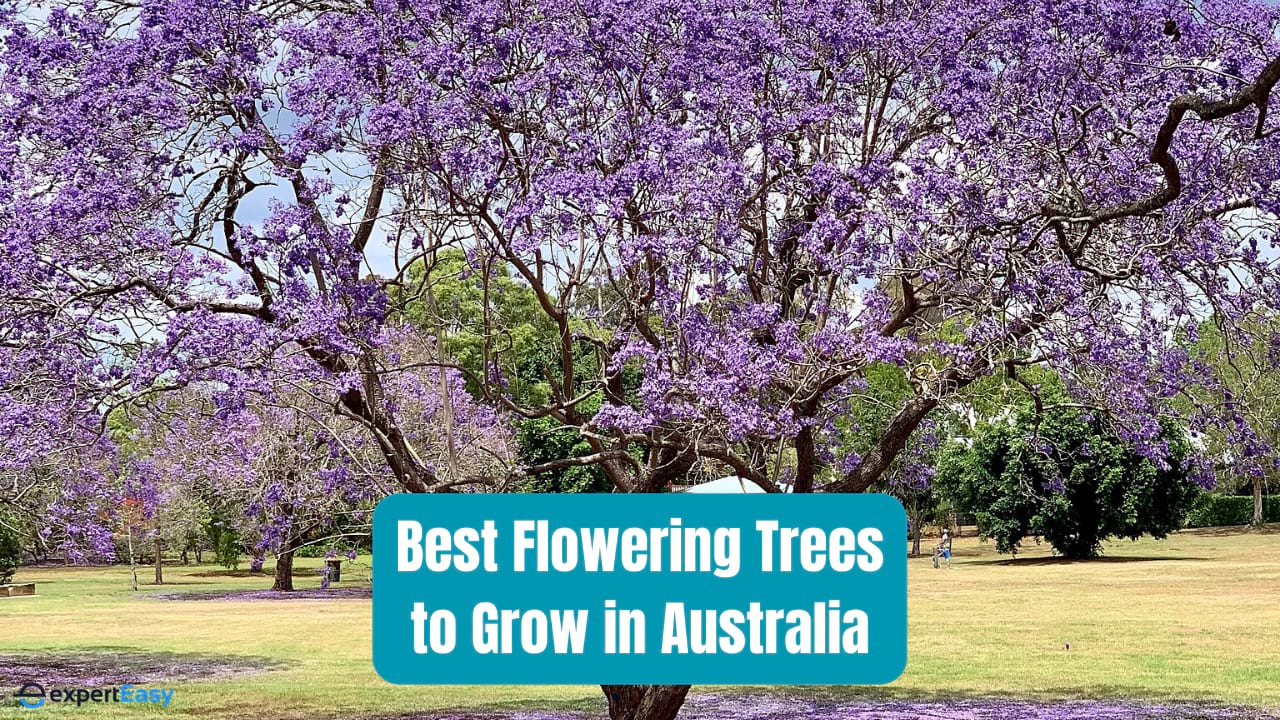Apple trees are one of the most rewarding fruit trees to grow in your backyard. Not only do they produce delicious, crunchy, and juicy apples, but they also lend charm and shade to your garden. But here's the crunch: growing apple trees isn't just about popping a seed in the soil and patiently awaiting its transformation into a fruit-bearing tree. It's a rewarding challenge that requires a well-thought-out strategy.
You need to choose the right variety for your climate, plant them in a sunny and well-drained spot, water and fertilise them regularly, and prune them to maintain their shape and health and protect them from pests and diseases. To help you on this journey, I’ll teach you to plant an apple tree with three different methods, along with expert tips and advice on how to care for your apple tree and enjoy its fruits for years to come.
About Apple Trees
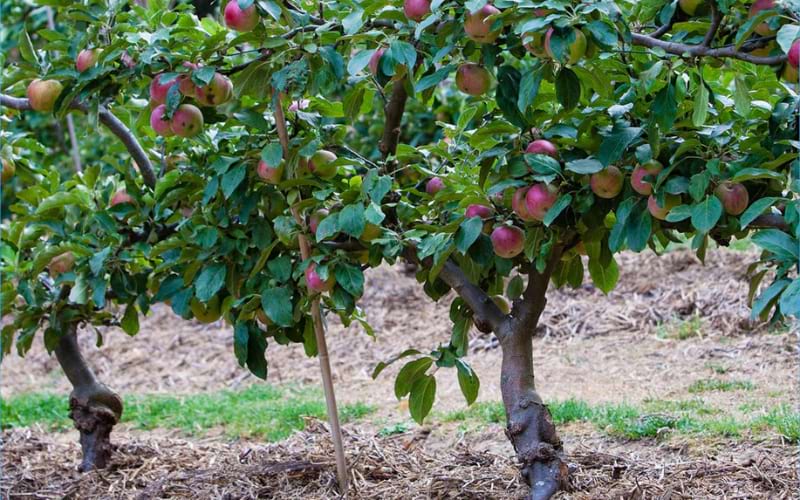
An apple tree is a fruit-bearing tree of the rose family that grows in temperate regions of the world. It has dark green oval leaves with serrated edges and white or pink flowers that bloom in spring. The flowers are pollinated by bees and other insects and produce round, fleshy fruits that vary in size, colour, flavour and texture depending on the variety. The fruits have thin skin, a core with seeds, and juicy and crisp flesh that can be eaten raw or cooked. Apple trees can grow up to 10 metres tall in the wild but are usually kept smaller by grafting and pruning in cultivation.
Apple trees have a long history of domestication and cultivation, dating back to ancient times in Central Asia. Ever since the first apple seeds were brought to Australia by the First Fleet in 1788, apple growers have been developing new and improved varieties to suit the diverse climates and tastes of this country. Australia, for instance, produces over 300,000 tonnes of apples every year, with more than 90% of them grown for fresh consumption. We also eat an average of 50 apples per person per year, or about one apple a week.
Botanical name: Malus domestica or Malus pumila
Common name: Apple
Family: Rosaceae
Native to: Central Asia and Afghanistan
Plant type: Small and Deciduous
Bloom time: Spring
Fruiting time: Autumn
Hardiness zone: 3-9 (depending on variety)
Soil type: Chalky, loamy, clay, sandy, moist, and well-drained
Soil pH: Slightly acidic or neutral (6-7)
Watering: Moderate and deep
Lighting: Full Sun to light/dappled shade
Temperature: Warm and cold season
Humidity: Moderate to High
Fertilising: Balanced fertiliser in early spring and late summer
Pruning: Annual pruning in late winter or early spring
Repotting: Every 2-3 years
Propagation: Seed, grafting, or budding
Toxicity: Seeds contain cyanide, and leaves may cause allergic reactions
Growth rate: Slow to moderate
Plant height: 2-10 meters (depending on variety)
Plant spread: 2-4 m
Colour of flowers: White or pink
Shape of leaves: Oval leaves with a pointed tip
Edges of Leaves: Serrated
Colour of Leaves: Dark green
How to Grow Apple Trees at Home
Growing an apple tree at home can be a rewarding and enjoyable experience. You can enjoy the beauty of the blossoms in spring, the shade of the leaves in summer, and the delicious fruits in autumn. However, growing an apple tree requires some planning, preparation, and care. We'll go over them first.
Choosing the Right Apple Tree Variety
The first step to growing apple trees is choosing the right variety for your region and your taste. There are hundreds of apple varieties available, each with different characteristics, such as size, colour, flavour, texture, ripening time, and storage life. Some varieties are better for eating fresh, while others are more suitable for cooking or juicing. To choose a variety, consider the following:
- The climate is the most important factor to consider when choosing an apple variety. Apple trees grow best in regions with a distinctly warm and cold season, where they can experience a period of winter chill. This is necessary for them to break dormancy and produce flowers and fruit. The amount of chill hours required varies depending on the variety but generally ranges from 300 to 1000 hours below 7°C. The most popular apple variety in Australia is Pink Lady Apple, which requires only 500 – 600 chill hours per year.
- Another factor to consider is pollination. Most apple varieties are not self-fertile, meaning they need another compatible variety nearby to cross-pollinate and bear fruit. This can be achieved by planting two or more different varieties within 50 metres of each other or by grafting two or more varieties onto the same tree. Still, some varieties, like Granny Smith, Golden Delicious, and Grimes Golden, are self-fertile, meaning they can produce fruit without another pollinator, even though they may benefit from cross-pollination.
- If you have limited space in your backyard, you may want to choose a dwarf or semi-dwarf apple tree. Smaller versions of regular apple trees can grow between 2 to 4 metres tall and wide. They can be grown in pots or containers or trained as espaliers along a wall or fence. They still produce full-sized fruit but in smaller quantities than regular apple trees.
Exploring Apple Varieties
To guide you in your apple variety selection, we've highlighted some of the popular apple varieties that thrive in Australia. Each of these varieties bring a unique character, offering a diverse range of flavours, textures, and uses:
- Red Delicious: As the name suggests, this large apple is a visual and gustatory delight. Cloaked in deep red skin, its flesh is sweet and crisp, making it a perfect choice for enjoying fresh or juicing.
- Granny Smith: This apple, dressed in vibrant green, is renowned for its tart and juicy flesh. It's versatile, being equally good for eating fresh, cooking or adding a refreshing zing to your juice.
- Fuji: The Fuji apple, wrapped in an appealing red skin, offers firm and ultra-sweet flesh. It's excellent for enjoying fresh or storing for future delights.
- Gala: This small, red-striped apple packs a punch with its crisp and sweet flesh. It's perfect for eating fresh or adding a juicy crunch to your salads.
- Pink Lady: This medium-sized apple, sporting an attractive pink-red skin, contains crunchy flesh that balances sweet and tart flavours beautifully. It's excellent for eating fresh or enhancing your baking with its unique taste.
- Golden Delicious: This yellow-green apple, true to its name, houses soft and sweet flesh. It shines when eaten fresh, cooked, or even dried for a longer shelf life.
- Jonagold: A large, enticing red-yellow apple, the Jonagold is a cross between Golden Delicious and Jonathan varieties. Its flesh is crisp and perfectly balances sweet and tart flavours. Enjoy it fresh, or try it in your cooking endeavours.
- Braeburn: Braeburn is adorned with red-orange streaks and has firm flesh that offers a spicy-sweet flavour. It's excellent for eating fresh or storing.
- Cox’s Orange Pippin: This medium-sized apple is known for its beautiful orange-red mottling over a yellow base. Its rich, aromatic, and tangy flesh makes it a great choice for fresh consumption or for making cider.
- Sundowner: The Sundowner is a medium red apple with crisp and sweet-tart flesh. It's excellent for savouring fresh or storing for later consumption.
How to Plant an Apple Tree in the Home Garden
You can plant an apple tree in your garden via any one of the following three plantation methods.
- Using a seed
- Using a graft
- Using a young plant
Using a Seed
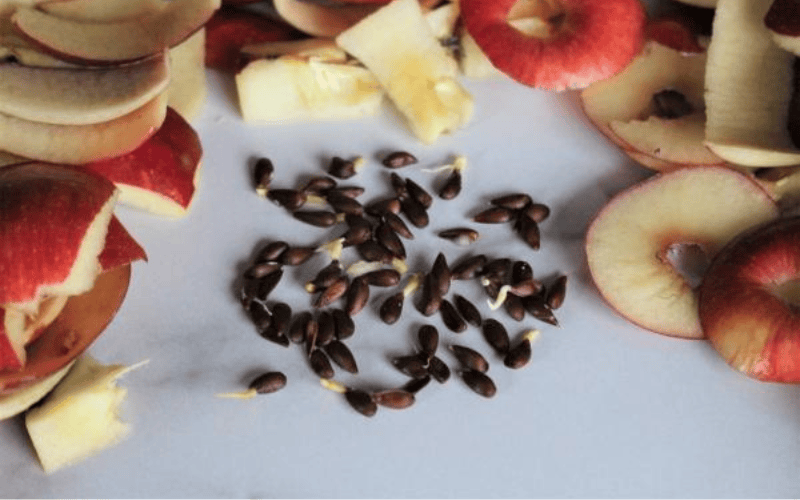
It may take 8 to 10 years for your apple tree to bear fruit from the seed. Here are the step-by-step instructions on how you can plant an apple tree using a seed.
- Collect two different kinds of seeds from an apple you like or buy apple seeds from a store. Make sure they are suitable for your climate zone and have compatible pollination requirements.
- Lay your seeds out to dry until there is no moisture on the outside shell.
- Cover your seeds with a damp paper towel and place them in a sealable plastic bag, jar or container. Put them in the fridge for 70 to 80 days to simulate winter and induce germination. This is called stratification.
- Prepare your pot and soil. Use a good potting mix and fill a small pot with drainage holes.
- Make a small hole in the soil with your fingertip, then drop the seed in and cover it with the soil. Water well and label the pot with the seed variety.
- Keep the soil slightly moist but not soggy, and place the pot in a warm and bright spot, such as a windowsill. You should see sprouts emerge in a few weeks.
- When the strongest seedlings are a few inches tall, transplant them to the ground if the weather is suitable. Choose a sunny and sheltered spot with deep, rich and well-drained soil. Dig a hole twice as wide and as deep as the root ball, and plant the seedling properly. Water well and mulch with organic material.
- Care for your apple tree by watering moderately and deeply, fertilising with a balanced fertiliser in early spring and late summer, pruning annually in late winter or early spring, and controlling pests and diseases with organic or non-organic methods. You can also thin out the fruits to improve their size and quality.
Using a Graft
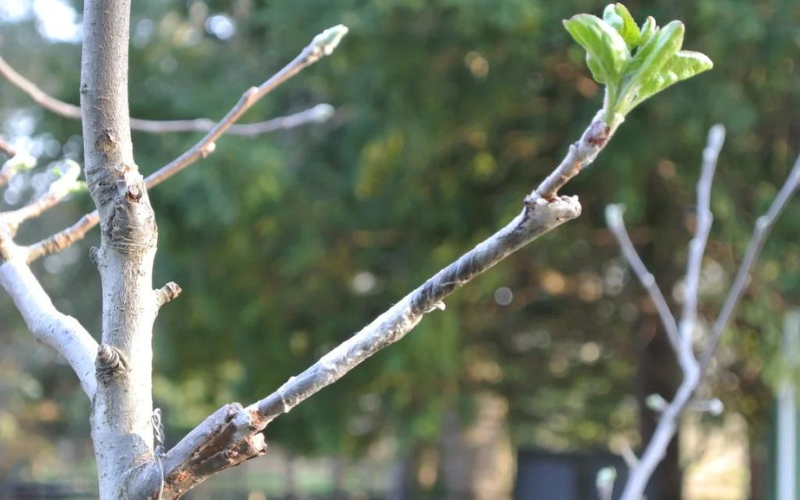
Grafting in propagation involves joining a part of a plant (scion) to another plant (rootstock) for the two parts to grow together and form a new plant. For apple trees, it may take 2 to 3 years to bear fruit from grafting. Here’s how to do that:
- Buy or source a healthy and suitable rootstock and scion for your apple tree. The rootstock controls the size and vigour of the tree, while the scion determines the fruit variety you want to grow. Make sure they are compatible and suitable for your climate zone and pollination requirements.
- Choose a sunny and sheltered spot with deep, rich, and well-drained soil to plant your rootstock. Dig a hole twice as wide and as deep as the root ball, and make sure the graft union is above the soil level. Water well and mulch with organic material.
- Choose a dormant season, such as late winter or early spring, to graft your scion onto your rootstock. Cut a healthy shoot from your scion variety that has at least three buds on it. Cut off any leaves or flowers from the shoot.
- Make a slanting cut at the base of the scion shoot, about 2 inches long. Make a matching cut at the tip of the rootstock branch where you want to graft it. The cuts should be smooth and clean, without any ragged edges or splits. Also, it should be at least 5 cm above the soil level to prevent root formation on the cutting.
- Fit the scion onto the rootstock, making sure that the cambium layers (the green layers under the bark) of both parts align well. The cambium layers are responsible for transporting nutrients and water between the roots and leaves, so they need to be in contact for successful grafting.
- Wrap the graft union tightly with grafting tape, rubber bands or strips of cloth to hold it in place and prevent moisture loss. Cover the tape with grafting wax, sealant, or paint to protect it from infection and drying out.
Using a Young Plant
Your apple tree may start bearing fruit in the same year or the next year of planting a young plant, depending on the age and variety of the tree. Here is the drill:
- Buy or source a healthy and suitable young apple tree from a nursery or online supplier. Make sure it is suitable for your climate zone and pollination requirements. You can choose from dwarf, semi-dwarf or standard-size trees, depending on your space and preference.
- Choose a sunny and sheltered spot with deep, rich and well-drained soil to plant your apple tree.
- Dig a hole twice as wide and as deep as the root ball and plant the young plant properly.
- Water well and mulch with organic material. Take good care of your plant throughout the year.
How to Plant an Apple Tree in a Pot or Container
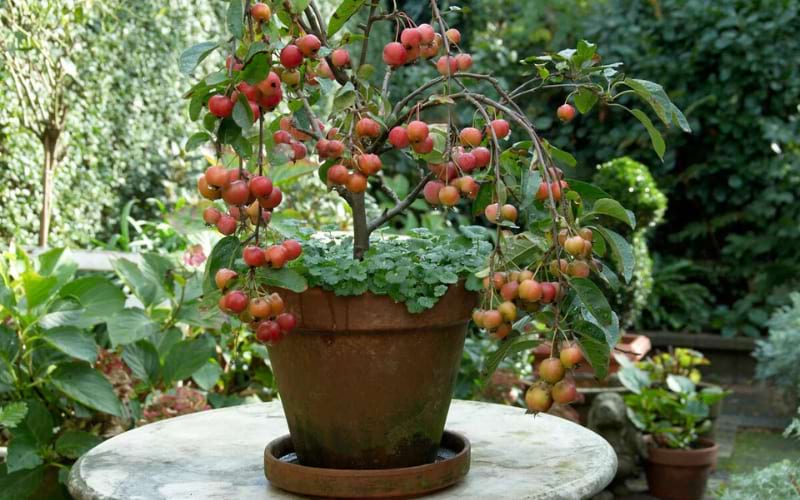
While it's possible to coax an apple tree to life from a seed or a graft, bear in mind that you may have to twiddle your thumbs for good before your tree decides it's ready to start producing fruit. I would recommend using a young plant to grow an apple tree in a pot or container. Here are the step-by-step instructions for planting an apple tree in a pot or container:
- Choose a suitable apple variety. Some of the apple varieties that are suitable for containers are Granny Smith, Red Delicious, Gala, Golden Delicious, Cripps Pink, Braeburn, Honeycrisp, Fuji, McIntosh and Crabapple. These varieties are either self-fertile, disease-resistant, cold-hardy or adaptable to various conditions. You can also choose a columnar or espaliered form for space-saving.
- Choose a large and sturdy container with drainage holes. The container should be at least 50cm in diameter and 40cm in depth, but bigger is better. You can use plastic, metal, ceramic or wooden pots, but make sure they are strong enough to support the weight of the tree and the soil. You can also get a wheeled base to put the pot on so you can easily move the tree around. Find the best plant pots, planters and baskets here.
- Fill the container with a good potting mix or a mix of compost and regular garden soil. Place some gravel or broken clay pot shards at the bottom of the container to facilitate drainage prior to planting the tree. You can also add some blood, fish and bone meal to the mix for good root establishment.
- Plant the young apple plant in the container. Back-fill with more potting mix or compost and soil mix, firming it gently as you go. Water well and mulch with organic material to lock in moisture and keep out weed seeds.
- Place the container in a sunny and sheltered spot that gets at least six hours of direct sunlight per day. Raise the container up on pot feet to help excess moisture drain away. You may need to move the container around to follow the sun or avoid frost during different seasons.
- Enjoy your apple tree, as it may start bearing fruit in 1-2 years after planting, depending on the age and variety of the tree. You may also need another compatible variety nearby for pollination unless you have a self-fertile variety.
Best Growing Conditions for an Apple Tree
Apple trees are versatile and adaptable plants that can grow in a range of conditions, but they do have some preferences that will help them thrive and produce quality fruits. Here are the best-growing conditions for an apple tree:
Soil
Apple trees prefer deep, rich, and well-drained soil that is slightly acidic (pH 6-7). They can tolerate clay or sandy soil but not waterlogged or excessively dry conditions. To improve the soil for planting, dig a hole twice as wide and as deep as the root ball of your apple tree and mix in some organic matter, such as compost or manure. This will also improve the soil structure, drainage, fertility, and moisture retention. Avoid planting apple trees in areas where the soil is too alkaline, saline, or compacted, as this may affect their nutrient uptake and root development.
Light
When it comes to selecting the perfect patch in your garden for your apple tree, remember this golden rule: the sunnier, the better. Apple trees bask in full sun, demanding a solid 6 hours of unfiltered sunlight each day, particularly during the fruitful growing season. Sunlight is the magic ingredient that catalyses the growth of robust branches, verdant leaves, and delectably sweet apples.
Avoid tucking your apple trees away in shady nooks or crowded corners where they might find themselves embroiled in fierce competition for light with other plants. Remember, your apple tree is a bit of a sunlight hog, and rightfully so.
Indoor apple plants, however, play by slightly different rules. With no access to direct sunlight, the answer is a grow light. Just as apple trees need a good six hours of sunlight outdoors, indoor apple plants will thrive with exposure to growing lights for 12-14 hours a day.
Temperature
Apple trees need a warm and cold season to grow and fruit well. They need a period of winter chill, when the temperatures are between 0°C and 7°C, to break dormancy and initiate flowering. The amount of chill hours required varies depending on the variety but generally ranges from 300 to 1000 hours per year.
They also need a warm and frost-free spring and summer, when the temperatures are between 15°C and 30°C, to support pollination, fruit set, and ripening. Avoid planting apple trees in areas where late frosts or extreme heat may damage the blossoms or fruits.
Humidity
Apple trees prefer moderate to high humidity (50-70%), which helps them to prevent water loss and maintain turgor pressure. However, they can tolerate dry or humid conditions as long as they are watered regularly and protected from fungal diseases. In this case, water the plant enough to reach the moisture content of 50-70% of the field moisture content of the soil.
Avoid planting apple trees in areas where the humidity is too high or too low, as this may affect their growth and fruit quality. You can use a humidifier to increase the humidity level inside your home, or else you can use a humidity controller to prevent the too-high or too-low humidity levels.
Season
The optimal time to plant your apple tree is during winter's chilly embrace when it lies dormant, and its roots are bare. This period of slumber gives the tree ample opportunity to get its roots settled and ready for a springtime burst of growth. On the other hand, if you've got a potted apple tree raring to go, you have the freedom to plant it throughout the year.
However, heed this piece of advice from the wise garden sage: steer clear of planting during the scorching highs of summer or the frosty depths of winter. Both extremes can be a bit harsh on your budding tree.
How to Care for an Apple Tree
Apple trees are relatively easy to care for once they are established. They require regular watering, fertilising, pruning and pest control to ensure healthy and productive growth.
Watering
Apple trees need moderate watering during the growing season, especially when they are young or bearing fruit. Water deeply and infrequently, rather than shallowly and frequently, to encourage deep root development. Avoid overwatering or underwatering, as this can cause stress and affect the fruit quality. Mulch around the base of your apple tree to retain moisture and prevent evaporation.
Fertilising
Apple trees need balanced fertilisation to support their growth and fruiting. Apply a complete fertiliser, such as blood and bone or citrus food, in early spring and late summer. Avoid over-fertilising, as this can cause excessive vegetative growth and reduce fruiting. If your soil is very acidic or alkaline, you may need to adjust the pH with lime or sulphur.
You can find some of the best fertilisers to plant your apple tree in Australia from Bunnings, Levity Crop Science, or Katek Fertilisers Australia. Other organic alternatives are Compost, Biosolids, or BioAgPhos.
Pruning
Apple trees need annual pruning to maintain their shape, size and productivity. Pruning also improves air circulation and sunlight penetration, which reduces the risk of diseases and pests. The best time to prune your apple tree is in late winter or early spring before the buds break. Use sharp pruning shears to remove any dead, diseased or damaged branches, as well as any crossing or rubbing branches. Thin out any crowded or weak branches to open up the centre of the tree. Cut back any long or vigorous branches to encourage lateral growth and fruiting spurs.
Good Hygiene Practices
You should practice good hygiene and sanitation when dealing with pests and diseases, such as washing your hands and tools before and after handling the plant, isolating any affected plants from others, disposing of any infected plant material properly, etc. You should also wear gloves when handling this plant as it can cause skin irritation due to its calcium oxalate crystals. This will help to prevent the spread of pests and diseases to other plants and avoid reinfection. Also, wear suitable gardening equipment for enhanced protection and safety while dealing with plant pests and diseases.
Managing Pests and Diseases
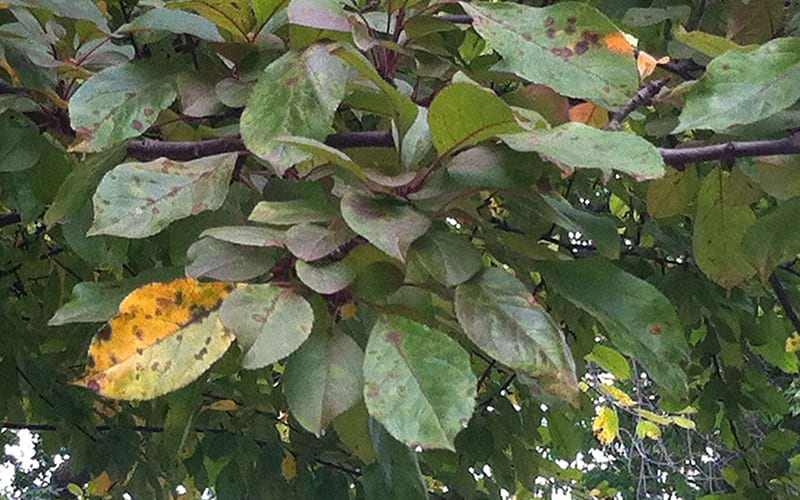
Apple trees are susceptible to various pests and diseases that can affect their growth and fruit quality. To tackle these problems, you need to identify the symptoms, apply the appropriate control measures and prevent future infestations. Here are some steps to take to deal with the common pest and disease problems of an apple tree:
- Aphids: These are small, sap-sucking insects that cluster on the undersides of leaves and stem, causing curling, yellowing and distortion. To control them, you can spray your apple tree with a systemic insecticide, a biological control (such as ladybugs or lacewings), or a homemade solution of water and soap. You can also prune and dispose of any infested branches or leaves.
- Apple scab: This is a fungal disease that causes black or brown spots on the leaves and fruits, leading to premature leaf fall and fruit rot. To control it, you can spray your apple tree with a fungicide, such as Luna Sensation, before the buds open in spring and repeat every 10 to 14 days until harvest. You can also rake and destroy any fallen leaves or fruits that may harbour the spores of the fungus.
- Codling moth: This is a pest that lays eggs on developing fruits, and the larvae burrow into the flesh, leaving brown trails and holes. To control it, you can use pheromone traps to capture the adult moths in spring and summer or spray your apple tree with an insecticide, such as spinosad or carbaryl, when the petals fall and repeat every 10 to 14 days until harvest. You can also remove and destroy any infested fruits or pupae that may be hiding in the bark of the tree.
- Fire blight: This is a bacterial disease that causes wilting, blackening and dieback of the shoots, leaves and flowers, as well as oozing of a sticky liquid from the infected parts. To control it, you can prune and dispose of any infected branches at least 12 inches below the visible symptoms, disinfecting your tools between cuts. You can also spray your apple tree with a bactericide, such as streptomycin or copper, during bloom time and repeat every 3 to 5 days until petal fall.
- Powdery mildew: This is a fungal disease that causes white or grey powdery patches on the leaves, stems and fruits, reducing their vigour and quality. To control it, you can spray your apple tree with a fungicide, such as Belanty, sulphur or neem oil, when the first signs of infection appear and repeat every 7 to 10 days until harvest. You can also prune and dispose of any infected branches or leaves to improve air circulation and reduce humidity around the tree.
When to Harvest Your Apples?
The time to harvest your apples in Australia depends on the variety of apples and the climate of your region. Generally, apple season in Australia lasts from summer until winter (from January to June). There are a few signs that can help you check if your apples are ripe and ready to harvest. Some of them are:
- Colour: Apples tell you they’re ripe by losing the last traces of their green background colour and developing full, bright colour. The inside of the apple’s colour will also give you an indication if it’s ready. The flesh should be white or cream - not green. The seeds should also be dark brown instead of white.
- Ease of separation: When your apples are ripe, they should be fairly easy to pick from the tree with a simple upward twist of the apple. If you have to pull hard or tug on the fruit, it is probably not ripe yet.
- Pip colour: The colour of the pips or seeds of the apple is another indicator of ripeness. They should be dark brown or black when the apple is ready to pick. If they are white or light brown, the apple is not ripe yet.
- Taste: The most reliable way to tell if an apple is ripe is to taste it. A ripe apple should be sweet, juicy and crunchy. If it is sour, dry or mealy, it is either unripe or overripe.
There are several popular apple varieties, each with its own distinct harvest time. Gala apples are typically harvested from February to May, offering a sweet and crisp flavor.
Red Delicious apples, known for their vibrant red color and slightly tart taste, are typically harvested between March and June. Granny Smith apples, famous for their tartness and green skin, are also harvested during the same period.
Fuji apples, known for their crisp texture and sweet flavor, are usually harvested from April to June. Finally, Pink Lady apples, which are known for their vibrant pink color and balanced sweetness, are also harvested from April to June.
How to Store Your Apples?
Apples can be kept reasonably well at room temperature for five to seven days, but it is suggested to keep them in a slightly dampened Swag in the fridge until the day before you’re ready to eat them. Placing the apples in the fridge or cold storeroom slows down the ripening process and can keep the apples fresh for a few weeks or months.
You can also keep your apples fresh for up to a year or more by placing them in a controlled atmosphere storage area. The reduced oxygen and increased carbon dioxide levels in these areas inhibit the production and action of ethylene, the hormone that triggers ripening. However, this method requires special equipment and monitoring and may affect the flavour and texture of some apple varieties.
Benefits of Growing an Apple Tree
Growing an apple tree in your home garden can have many benefits, such as:
- Providing you with fresh, organic, and nutritious apples that you can enjoy and share with your family and friends. Apples are rich in fibre, vitamin C, antioxidants, and other phytochemicals that can boost your health and immunity.
- Saving you money and reducing your environmental impact by avoiding buying apples from the store that may have been sprayed with pesticides, transported long distances, and stored for a long time.
- Enhancing the beauty and diversity of your landscape with the attractive blossoms, foliage, and fruits of the apple tree. Apple trees can also attract pollinators, birds, and other wildlife to your garden, creating a natural ecosystem.
- Offering you a rewarding and enjoyable hobby that can improve your physical and mental well-being. Growing an apple tree can give you a sense of accomplishment, satisfaction, and relaxation, as well as an opportunity to learn new skills and connect with nature.
- Apple trees have been valued for their fruit, wood, cider, and vinegar, as well as for their symbolic and cultural significance in many traditions.
- Apple trees are also important for biodiversity, as they provide food and shelter for many animals and insects.
Are you planning a garden redesign or in need of some landscaping advice? Our guide on how to find the best landscaper in Australia is a great resource. These professionals provide everything from design inspiration to full-service landscaping, helping you transform your outdoor space into a beautiful garden masterpiece.
🪴Need Assistance With Gardening?
Whether you're a seasoned green thumb or just starting out in gardening, there's always more to learn. Immerse yourself in our guide to finding the perfect gardener in Australia. These top-rated professionals offer a variety of services, from plant selection to garden maintenance, ensuring your garden remains vibrant and healthy.
🌲Seeking Help With Lawn Care?
Maintaining a beautiful lawn can be a significant undertaking. If you're in need of expert assistance, look no further than our carefully curated guide on choosing the right lawn mowing service in Australia. These experts can help keep your outdoor spaces at their greenest and cleanest best with their lawn mowing and care expertise.
Frequently Asked Questions (FAQs)
Here are some frequently asked questions about growing apple trees.
What is the easiest apple to grow?
Some of the apple varieties that are generally considered easy to grow are Granny Smith, Red Delicious, Gala, Golden Delicious, Cripps Pink, Braeburn, Honeycrisp, Fuji, McIntosh, and Crabapple. These varieties are either self-fertile, disease-resistant, cold-hardy, or adaptable to various conditions. You can choose one or more of these varieties based on your preferences and needs.
Can apples grow in cold climates?
Yes, apples can grow in cold climates, as long as they receive enough chill hours (temperatures between freezing to 7 degrees Celsius) during the winter to break dormancy and initiate flowering. The amount of chill hours required varies depending on the variety but generally ranges from 300 to 1000 hours.
Some of the apple varieties that are especially suitable for cold climates are Honeycrisp, McIntosh, Haralson, Liberty, Freedom and Redfree. These varieties are robust and can endure harsh conditions in Australia, such as in the high country of Victoria and New South Wales, where temperatures can drop as low as -20 degrees Celsius.
How long will an apple tree take to bear its first fruit?
The time it takes for an apple tree to bear its first fruit depends on the rootstock and the variety of the tree. The rootstock controls the size and vigour of the tree, while the variety determines the fruit type and quality.
Generally speaking, dwarf apple trees (which grow up to 10 feet tall) will start bearing fruit 2 to 3 years after planting, semi-dwarf apple trees (which grow up to 15 feet tall) will start bearing fruit 3 to 4 years after planting, and standard apple trees (which grow up to 30 feet tall) will start bearing fruit 6 to 10 years after planting.
However, some varieties may bear fruit earlier or later than others, depending on their genetic characteristics and growing conditions.
How do I know if my apple tree needs water?
Apple trees need moderate and deep watering during the growing season, especially when they are young or bearing fruit. To know if your apple tree needs water, you can check the soil moisture around the root zone of the tree. The soil should feel moist but not soggy or dry.
You can also look for signs of water stress on the tree, such as wilting, curling, or yellowing of leaves, cracking or splitting of fruits, or premature leaf fall. If you notice any of these symptoms, you may need to adjust your watering frequency or amount accordingly.
How much space do you need to plant apple trees?
Generally speaking, standard apple trees (which grow up to 30 feet tall) need at least 25 feet of space between them, semi-dwarf apple trees (which grow up to 15 feet tall) need at least 15 feet of space between them, and dwarf apple trees (which grow up to 10 feet tall) need at least 10 feet of space between them.
However, some apple trees can be trained to grow in a columnar or espaliered form, which can reduce the space they need considerably. Columnar apple trees (which grow up to 3.5 feet tall and 2 feet wide) can be planted as close as 2 feet apart, while espaliered apple trees (which grow flat along a wall or fence) can be planted as close as 6 feet apart.
How far apart should apple trees be planted?
If you are planting more than one apple tree, space them at least 3 metres apart for dwarf varieties, 4 metres apart for semi-dwarf varieties, and 6 metres apart for regular varieties. This will allow enough room for air circulation and sunlight penetration.
However, you also need to consider the pollination requirements of your apple trees, as most of them are not self-fertile and need another compatible variety nearby to produce fruit. If you have limited space, you can plant two or more varieties on the same rootstock, which is called a multi-grafted or family tree. This way, you can have cross-pollination and multiple types of apples on one tree.
Which soil is best for growing apple trees?
Apple trees prefer deep, rich, and well-drained soil that is slightly acidic (pH 6-7). They can tolerate clay or sandy soil but not waterlogged or excessively dry conditions. To improve the soil for planting, dig a hole twice as wide and as deep as the root ball of your apple tree and mix in some organic matter, such as compost or manure.
This will help to improve the soil structure, drainage, fertility, and moisture retention. Avoid planting apple trees in areas where the soil is too alkaline, saline, or compacted, as this may affect their nutrient uptake and root development.
What are the four most popular apples in Australia?
According to Hort Innovation Australia, the most popular apple in Australia is Pink Lady, followed by Royal Gala, Granny Smith, and Fuji. Pink Lady apples are known for their pink-red skin, crisp texture, and sweet-tart flavour. They are suitable for eating fresh or cooking. Royal Gala apples are known for their yellow skin with red stripes, juicy flesh, and mild flavour. They are best for eating fresh or juicing.
Granny Smith apples are known for their green skin, firm flesh, and sour flavour. They are ideal for cooking or baking. Fuji apples are known for their red skin with yellow-green patches, dense flesh, and honey-like flavour. They are good for eating fresh or making cider.
How long does it take to grow apples in Australia?
Generally speaking, dwarf apple trees (which grow up to 10 feet tall) will start bearing fruit 2 to 3 years after planting, semi-dwarf apple trees (which grow up to 15 feet tall) will start bearing fruit 3 to 4 years after planting, and standard apple trees (which grow up to 30 feet tall) will start bearing fruit 6 to 10 years after planting. However, some varieties may bear fruit earlier or later than others, depending on their genetic characteristics and growing conditions.
How can I confirm if my apples are ripe?
Apples are harvested in autumn (between January and June), but some varieties may ripen earlier or later than others. For example, Gala apples are usually ready in February or March, while Granny Smith apples are usually ready in April or May. The best way to tell if your apples are ripe is to taste them. If they are sweet and crunchy, they are ready. You can also look for other signs of ripeness, such as full-colour development, easy detachment from the stem, and brown seeds inside.
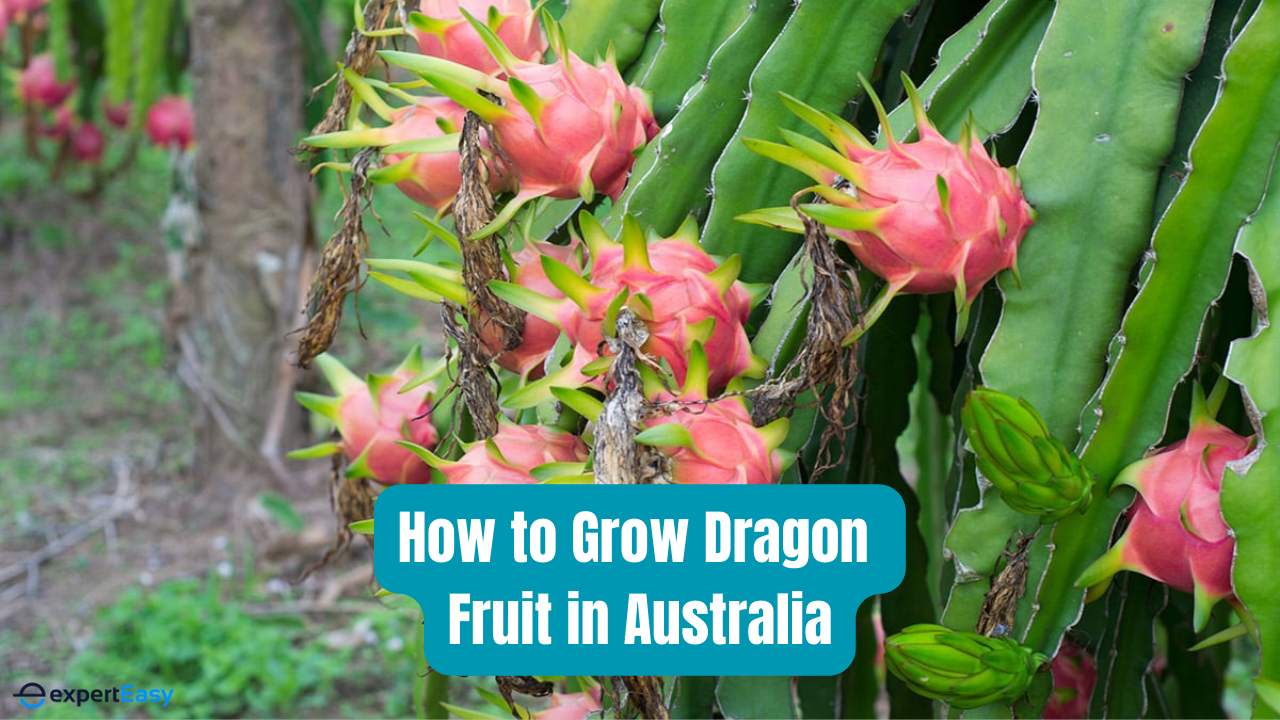
Wrapping Up
Growing apple trees in your home can be a rewarding experience, but it requires some planning, preparation, and care. You need to choose the right variety, size, and method of planting for your space and conditions. You also need to provide your apple tree with the best-growing conditions and maintenance to ensure a healthy and productive tree. With proper technique and care, you can enjoy fresh, crunchy, and juicy apples from your own backyard, as well as the shade and beauty of the apple tree.
I hope you liked my article and learned something new about growing apple trees in your home in Australia. If you have any questions, comments, or tips, please feel free to share them below. I would love to hear from you and learn from your experience. Here's to fruitful gardening adventures ahead.

